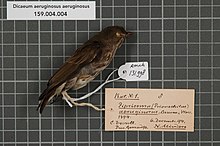| Striped flowerpecker | |
|---|---|

| |

| |
| Conservation status | |
 Least Concern (IUCN 3.1) | |
| Scientific classification | |
| Domain: | Eukaryota |
| Kingdom: | Animalia |
| Phylum: | Chordata |
| Class: | Aves |
| Order: | Passeriformes |
| Family: | Dicaeidae |
| Genus: | Dicaeum |
| Species: | D. aeruginosum |
| Binomial name | |
| Dicaeum aeruginosum (Bourns & Worcester, 1894) | |
| Synonyms | |
|
Dicaeum agile aeruginosum | |
The striped flowerpecker (Dicaeum aeruginosum) is a species of bird in the family Dicaeidae. It is endemic to the Philippines. Its natural habitats are tropical moist lowland forest and tropical moist montane forest. It is part of the Thick-billed flowerpecker species complex and was formerly conspecific with it.
Description and taxonomy
EBird describes the Thick-billed flowerpecker species complex as "Dull gray-brown flowerpecker with streaked white underparts. Unremarkable; bill isn’t all that noticeably thick, but combination of pale vent, striped throat, and (in some subspecies) strongly streaked underparts serve to identify this wide-ranging and variable species. Like many other flowerpeckers, often associated with mistletoe, but can be found in a variety of forest types and elevations. Often heard giving a hard, slightly wet “tsip!”
In comparison to the thick-billed flowerpecker. it is more olive-green above, more greenish on lower back to uppertail-coverts and much more bold striping
Subspecies
Three subspecies are recognized:
- D. a. aeruginosum – Found on Luzon, Lubang, Romblon, Sibuyan and Catanduanes
- D. a. striatissimum – Found on Mindoro, Negros, Cebu and Mindanao
- D. a. affine – Found on Palawan
Ecology and behavior
Feeds on small fruits, mistletoes, flowers and also takes small insects. Forages mostly in the canopy and middle stratum. Found singly, in pairs or mixed species flocks with other flowerpeckers and small birds. Breeding is completely unknown.
Habitat and conservation status
It is found in tropical moist lowland forest and montane forest up to 3,000 meters above sea level.
The International Union for Conservation of Nature does not recognize this species as separate yet and does not have an assessment. This species is generally uncommon and poorly known but can easily be overlooked. Due to the ongoing habitat destruction across the entire Philippines, it is likely that this species population is declining. Surveys are required to better understand biology, population density and range.
References
- BirdLife International (2012). "Dicaeum aeruginosum". IUCN Red List of Threatened Species. 2012. Retrieved 26 November 2013.{{cite iucn}}: old-form url (help)
- "Thick-billed Flowerpecker - eBird". ebird.org. Retrieved 2024-09-07.
- ^ Cheke, Robert; Mann, Clive (2020). "Thick-billed Flowerpecker (Dicaeum agile), version 1.0". Birds of the World. doi:10.2173/bow.thbflo1.01. ISSN 2771-3105.
- IUCN (2016-10-01). Dicaeum agile: BirdLife International: The IUCN Red List of Threatened Species 2017: e.T105991992A111181409 (Report). International Union for Conservation of Nature. doi:10.2305/iucn.uk.2017-1.rlts.t105991992a111181409.en.
| Taxon identifiers | |
|---|---|
| Dicaeum aeruginosum | |
This Dicaeidae-related article is a stub. You can help Misplaced Pages by expanding it. |